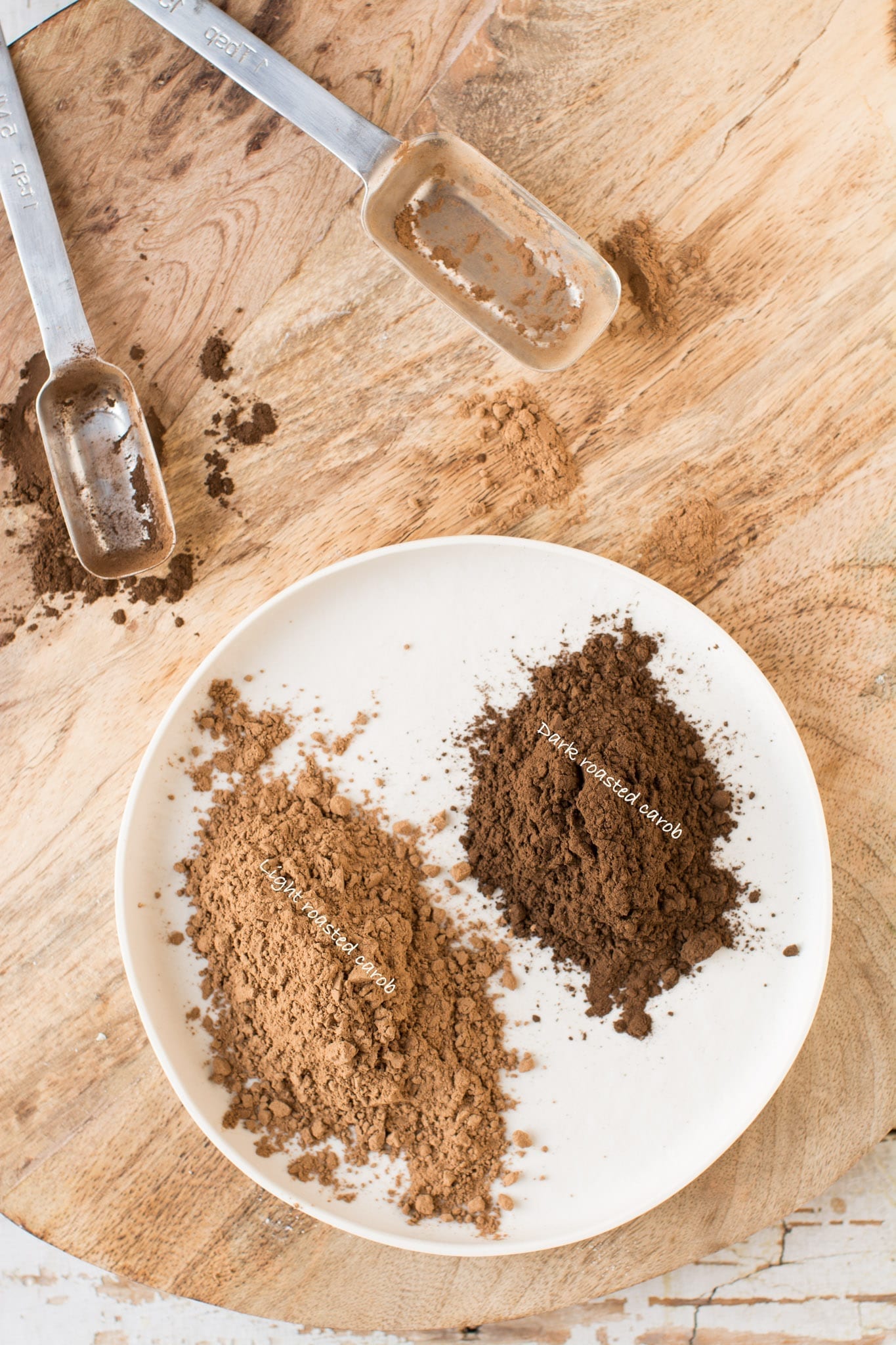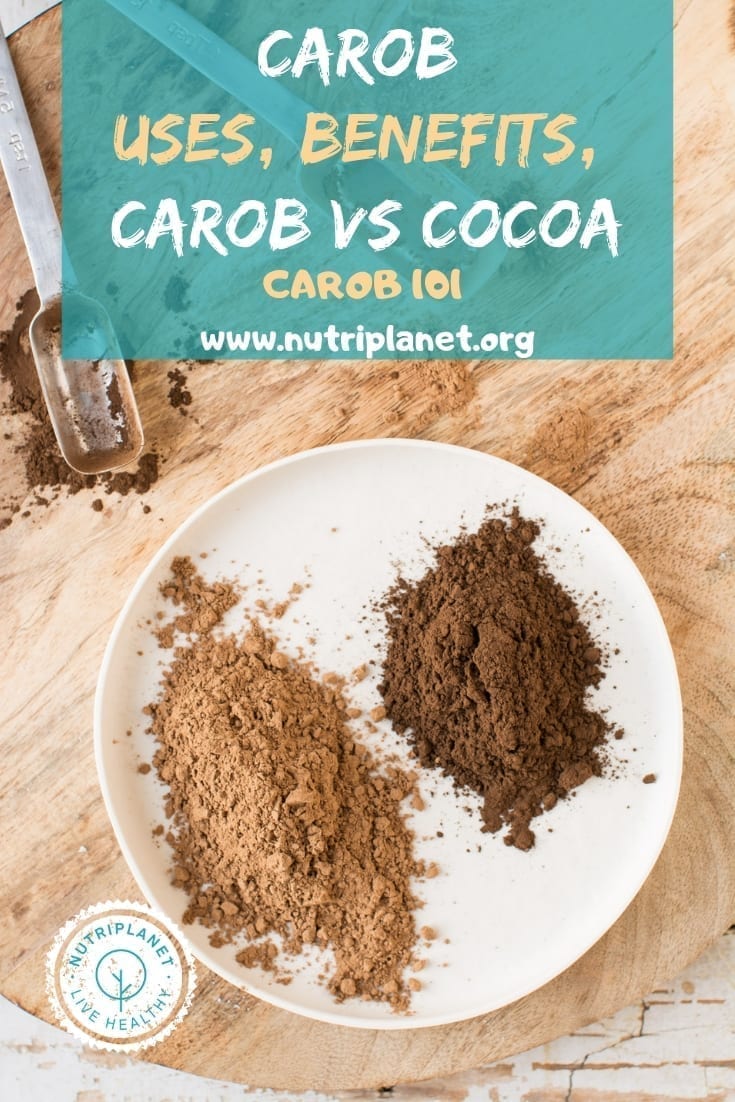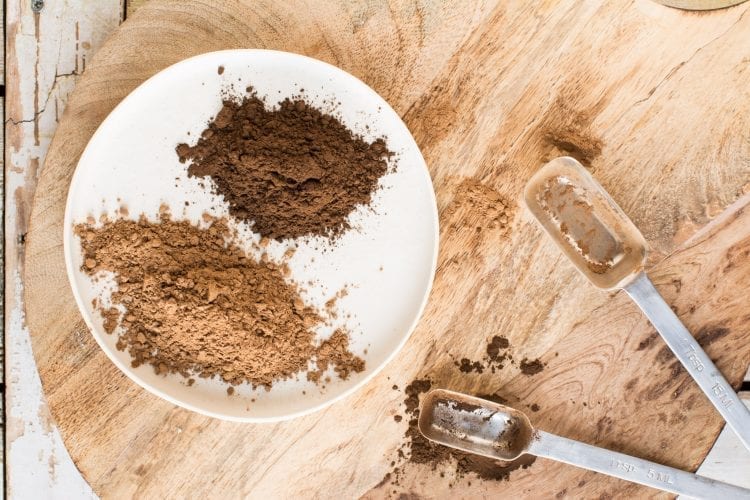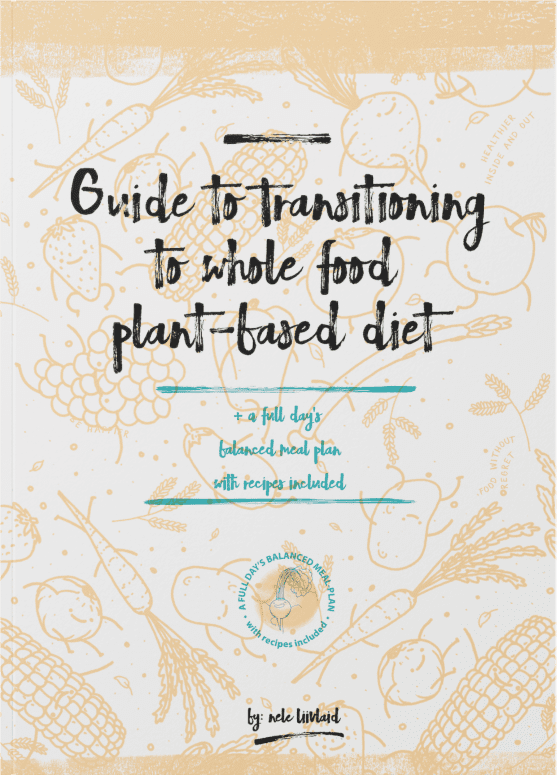Read all about carob: what is carob, carob benefits, uses of carob, carob vs cocoa, what’s the difference between raw and roasted carob powder, and how to use carob powder for cooking.
What is carob?
Let’s start with describing the carob tree. Ceratonia siliqua, known as carob (from Arabic خَرُّوبٌ (kharrūb) and Hebrew חרוב (haruv)), St John’s bread, locust bean (not African locust bean), locust-tree, or carob bush is a flowering evergreen tree or shrub in the pea family. Its pods have been used for food for as long as 5,000 years. Carob is also used as an ornamental tree in gardens and landscapes.
The carob tree is native to the Mediterranean region, including Southern Europe, Northern Africa, the larger Mediterranean islands, the Levant and Middle-East of Western Asia into Iran, and the Canary Islands and Macaronesia in the Atlantic Ocean.

Uses of carob
It must be noted that carob tree is a very good asset in terms of its uses:
- The ripe, dried, and sometimes toasted, carob pods are ground into carob powder, which can be used to replace cocoa powder.
- As carob is naturally sweet, the powder can be used as sweetener in baked goods, candies, and desserts.
- Also, the crushed pods may be used to make a beverage, a replacement to hot chocolate.
- Since carob pods are about ⅓ to ½ sugar by weight, carob is also used for compote, liqueur, and syrup.
- Next, a thickening agent used in the food industry, is the most important use of carob seeds economically. Locust bean gum or carob gum is used as a thickening agent and stabilizer, or as a substitute for gluten in low-calorie products. To make 1 kilogram (2.2 lb) of locust bean gum, 3 kilograms (6.6 lb) of carob seeds are needed, which must come from roughly 30 kilograms (66 lb) of carob pod fruit.
- Finally, it’s interesting to know that carob benefits are not limited to humans. As carob doesn’t contain theobromine or caffeine, it is also used to make chocolate-like treats for dogs.
Medicinal use of carob
As it turns out, carob is not only pretty or tasty, it also has healing powers. Let’s list some of those below!
- Medicinally, carob is used for digestion problems including diarrhoea, heartburn, and the intestine’s inability to properly absorb certain nutrients from food.
- Other uses of carob include treatment of obesity, vomiting during pregnancy, and high cholesterol.
- Finally, in infants, carob is used for vomiting, retching cough, and diarrhoea.
Carob Benefits
Besides the above mentioned medicinal uses, carob also has many more health benefits you might want to be aware of:
- Firstly, it is a good source of vitamins and minerals, like calcium, zinc, potassium, phosphorus, vitamin K, riboflavin, and vitamin E.
- Secondly, carob is low in fat (0%) and sodium (2.3mg per tablespoon).
- Thirdly, it contains calcium (22.4mg per tablespoon), but no oxalates that would inhibit its absorption.
- It’s noteworthy, that the fibre found in carob (2.6g per tablespoon) is somewhat special. More precisely, it inhibits the secretion of postprandial ghrelin, a hormone that tells the body that it is hungry, occasionally released after eating. This means that carob can reduce the chances of overeating, and therefore aid in weight loss attempts.
- Next, carob improves digestion and helps to relieve diarrhoea thanks to its tannin content.
- Carob is also a good source of antioxidants and therefore slows down ageing and reduces the risk of cancer.
- It also boosts immune system and manages diabetes.
- And finally, carob is gluten-free and caffeine-free. That’s good news for everyone who can’t tolerate gluten and/or caffeine.
Carob vs Cocoa
It might be that the difference between carob and cocoa is unclear to you. So, I give you the main distinctions:
- Firstly, carob pods are naturally sweet, but cacao is bitter.
- It’s important to note that cacao contains theobromine (toxic to dogs and cats in large quantities), tyramine (an amino acid that may trigger migraines) and caffeine, while carob does not. Too much caffeine can cause insomnia, irritability, upset stomach, fast heart rate, and muscle tremor.
- While cacao is high in oxalates, carob has none.
- Next, carob powder has three times as much calcium compared to cocoa powder.
- Finally, cocoa is high in fat and carob has zero fat.
Adverse effects of cocoa
So, what’s the fuss about cocoa or cacao anyway? Why should you replace it in the first place?
Well, it’s because cacao and products containing cacao can be too stimulating for some people because of caffeine, theobromine and tyramine.
Theobromine is a bitter alkaloid of the cacao plant, the tea plant, yerba mate, guarana berry and the kola nut. It has an effect similar to, but lesser than, that of caffeine in the human nervous system. Theobromine widens blood vessels, promotes increased production of urine and stimulates heart. At doses of 0.8–1.5 g/day (50–100 g cocoa), sweating, trembling and severe headaches were noted.
Moving on, tyramine as well as caffeine, are both well-accepted migraine triggers. So, if you’re having headaches or migraines, you might want to think twice before reaching for another cup of coffee or piece of dark chocolate. It’s noteworthy though that the levels of tyramine in cacao butter are undetectable. [source]
Raw vs roasted carob powder
It might be that you’ve come across very different carob powders, from light beige to dark brown. Well, that’s because there are three varieties of carob powder (in terms of roasting):
- Raw carob powder – either no heat or under 47.7°C (118°F), of a light brown colour. Raw carob is subtly sweet and not at all bitter with a pleasant almost caramel-like taste.
- Slightly roasted carob – heated to about 93°C (200°F) and is of a lighter-dark brown colour. This variety has the sweetest taste. It is often referred to as raw carob powder.
- Dark-roasted carob – high heat roasted up to 204°C (400°F) and is of dark brown colour. Resembles cocoa the most as it becomes a bit bitter of taste.
I personally have tasted only the roasted varieties and I can tell you, that the dark-roasted carob is really intense! So, I like to combine the two or use only slightly roasted carob.
How to use carob powder in cooking
I bet you’re waiting to know how you can use carob powder in everyday cooking! Fortunately, it’s a very versatile powder that has many yummy uses:
- Make carob pancakes, carob brownies, carob cookies, carob cakes and carob candies.
- Use carob in any recipes that call for cocoa powder. However, you probably need to use less sweetener or none at all as carob is naturally sweet.
- Add carob powder to smoothies, porridge or dessert bowls.
- Make hot carob drink instead of hot chocolate – simply mix together plant milk and carob powder.
- Whip up a delicious carob-avocado pudding or coconut cream-carob pudding.
- Make carob bars (carob chocolate) and carob chips.
I hope you enjoyed this article about carob benefits and uses! If you have some fascinating facts or info that was not covered, I’d appreciate if you let me know in the comments below!
Disclaimer: this post contains affiliate links. As an Amazon Associate I earn from qualifying purchases.

Sources:
https://en.wikipedia.org/wiki/Ceratonia_siliqua
https://en.wikipedia.org/wiki/Theobromine
https://www.webmd.com/migraines-headaches/tyramine-and-migraines#1
https://www.webmd.com/vitamins/ai/ingredientmono-321/carob
https://academic.oup.com/jn/article/136/6/1533/4664376
https://www.healthline.com/health/food-nutrition/carob-powder#nutrition-facts
https://www.organicfacts.net/health-benefits/other/health-benefits-of-carob.html





































Positive, thumbs up!
Thank you Carol!
Hi Nele 🙂 I have some doubts, I don’t know if I can eat carob syrup during my Candida diet. I’ve already followed the diet for two months to treat my dyshidrosis and have seen a big improvement. And I also want to know if I can eat fresh lucuma fruit because there isn’t enough information related to candida online. Thank you in advance
Hi! Any syrups are a no-go on Candida cleanse. Carob powder is a whole other thing as it contains plenty of fibre.
Lucuma powder is ok to consume so I’m guessing also the fresh fruit should be.